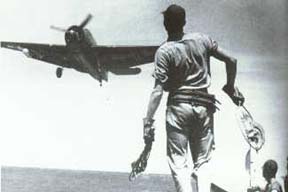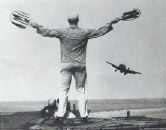Another part of the flight training was firing machines guns
at a towed target. A fighter plane is basically a flying gun
platform, in the case of the F4F, four 50 caliber machine guns.
The guns were stationary and arranged two in each wing firing
forward and bore sighted so the projectiles from the four guns
will converge at a point seven hundred feet a head of the plane.
For our practice sessions and to conserve on ammunition the four
guns were loaded with 100 rounds each. To aim the guns there
is a gun sight mounted behind the wind shield and on top of the
instrumental panel directly in front of the pilot making it possible
for the pilot to draw a bead on his objective and hit it with
machine gun fire. The gun sight is marked off lighted rings that
are calibrated in mils from the center to the outside ring. Using
these markings makes it possible for the projectiles to hit the
target. To hit an enemy plane from a high speed, high angle run
it is necessary to get about a 90 mil lead on the your prey.
When we had gunnery practice one of the students would be assigned
to tow the target and the other six and the instructor would
make firing runs until their ammo was exhausted or the target
was shot off. At the end of the flight we would gather around
the sleeve and count holes. The tip of the round was painted
a different color for each of the planes for identification.
If we were lucky we would find 1 or 2 or 3 or 4 or maybe 8 or
even 10. That is a very few holes for 2800 rounds of ammo. Impressive?
Not very! Not to worry! I would learn later. Don't know if the
rest of my flight learned to shoot at a later time or not. Don't
mistake these gunnery runs with the movies where the " HOT
PILOT' sucks in behind the enemy and blows him full of holes.
Any "macaroon" can do that. Basically, our lack of
knowledge and skill was another case of the instructor not knowing
any more than the students.
It was here at Green Cove Springs that we began our training
in the technique of carrier landings. There was no carrier near
the air station so , as with all other operational schools, an
out lying field was marked with the outline of a carrier deck
with the location of the arresting wires painted on the deck.
The LSO's (Landing signal officer) platform was also outlined
in it's proper place. We were instructed on making a routine
approach by flying upwind at about 500 feet of altitude. About
a quarter mile ahead of the painted carrier deck we were to make
a 90 degree left turn and let down to 100 feet of altitude, continue
cross wind ( that is 90 degrees to the course of a carrier sailing
into the wind) to about a quarter of a mile to the left and ahead
of the "carrier" make a 90 degree left turn and fly
down wind. At a point opposite the LSO we were to make a left
turn letting down to about fifty feet of altitude. We continue
this cross wind approach to a point about 30 degrees off the
course of the "carrier". There we begin a turn into
the stern of the "carrier".

Landing Signal Officer (LSO) |
At this point the LSO picks you up with his paddles and
directs your plane into a landing aboard the "carrier"
by making motions with the paddles. He will tell you the attitude
of your plane and what corrections are required to make to pick
up an imaginary wire and make a safe landing. It is absolutely
essential that you follow the instructions of the LSO to the
letter. It has been proven by experience that he knows your flying
speed and attitude in the groove better than you do. Try to out
guess him and there's a good chance you will die. |
The reason I'm describing this procedure is for relating the
only accident experienced by a member of our flight at Green
Cove Springs. On one of the several circles for practice landings,
Walt Glista, on a left hand turn and let down, stalled his plane
and spun in from about 500 feet. He crashed in a field of tree
stumps, tore the plane into a mass of twisted wreckage. He walked
away unhurt. I don't believe he was even reprimanded-- he finished
the program with the rest of us.
|
As for this stage of the program, flying close to stalling speed
and just above the tree tops, was a little spooky at first. After
getting use to this way of flying, I really began to enjoy it.
The real McCoy was yet to come, that is, landing on moving, tossing,
rolling carrier flight deck. |

LSO |
Night flying wasn't much different except for formation flying.
The only thing about formation flying was finding the planes
after taking off. On a black night all you could see were the
running lights of the planes and you had to find your own division
quickly or try to select your flight out of all the other planes
in the air. Sometimes it was a crowded sky.
One thing I got a kick out of was making passes at trains that
traveled up and down the coast. Not much to it but it was exciting
to come down from a couple of thousand feet as hard as the plane
would go, level off just above the tracks and head right into
the headlight of the train. then pull up at the last second and
skin down the length of the train. Doubt very much that engineer
even knew we were there. Might have heard the noise, though. |
|
|